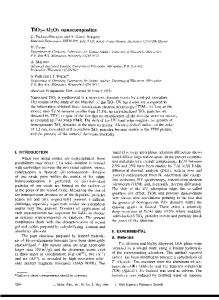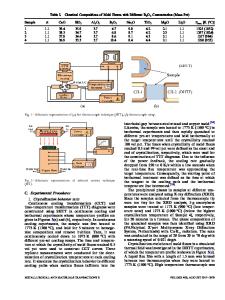Stability of Fluorine-Free CaO-SiO 2 -Al 2 O 3 -B 2 O 3 -Na 2 O Mold Fluxes
- PDF / 980,150 Bytes
- 9 Pages / 593.972 x 792 pts Page_size
- 0 Downloads / 415 Views
evelopment of fluorine-free mold fluxes is important for decreasing environmental impact, equipment corrosion, and health hazards brought about by the presence of fluorine in the conventional mold fluxes.[1–4] Many trials have been conducted to replace fluorides with other components.[1–3,5,6] It was suggested that the combination of B2O3 and Na2O is an appropriate substitute for CaF2, providing low viscosity and melting temperature, and acceptable crystallization and heat transfer of mold fluxes.[2,7,8] However, high volatility of sodium- and boron-containing compounds can be a limitation in the industrial use of the Na2O-containing boracic fluxes.[9–12] The CaO/SiO2 ratio is an important characteristic of mold fluxes used in industry, because it is correlated with flux thermophysical properties such as crystallization,[13–15] heat transfer,[16–18] melting properties, and viscosity.[1,5,19,20] It was also reported that CaO/SiO2 ratio affects the flux evaporation because of the alteration of flux viscosity and the diffusion process in the molten flux.[10,11] The evaporation of high-volatile components changes the chemical compositions of mold fluxes, and thus their physicochemical properties. The changes of mold flux properties can lead to unstable heat transfer and insufficient lubrication, resulting in severe surface defects, e.g., cracks and depressions.[21] Thus, knowledge of kinetics and mechanism of evaporation of mold fluxes containing both B2O3 and Na2O is LIN WANG, JIANQIANG ZHANG, YASUSHI SASAKI, and OLEG OSTROVSKI are with the School of Materials Science and Engineering, UNSW Australia, Sydney, 2052, Australia. Contact e-mail: [email protected] CHEN ZHANG and DEXIANG CAI are with the Steelmaking Research Department, Baosteel Group Corporation Research Institute, Shanghai, 201900, China. Manuscript submitted October 11, 2016. Article published online January 3, 2017. METALLURGICAL AND MATERIALS TRANSACTIONS B
important for the development of the fluorine-free mold fluxes. However, limited publications in this area showed that the evaporation is very complex, depending on the flux composition and temperature, and the mechanism of the evaporation has not been established. The purpose of this work is to study the evaporation of CaO-SiO2-Al2O3-B2O3-Na2O mold fluxes using thermogravimetric analysis (TGA), focusing on the effects of the Na2O content and CaO/SiO2 ratio.
II.
EXPERIMENTAL PROCEDURE
A. Flux Preparation Flux samples were prepared using chemical reagents of CaCO3, Na2CO3, SiO2, Al2O3, MgO, and B2O3 powders. The mixture of components was ground in an agate mortar for 20 minutes, and then placed in a high-purity graphite crucible. After heating and melting at 1673 K (1400 °C), and holding at this temperature for 20 minutes, the flux was poured onto a steel plate and cooled to room temperature. Subsequently, the flux samples were crushed and ground to fine powders. Compositions of fluxes were analyzed by inductively coupled plasma (ICP) for B2O3 and X-ray fluorescence (XRF) for other oxides; the results are listed in Table I.
Data Loading...











